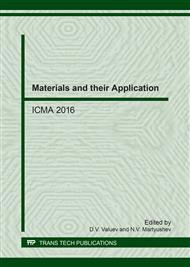[1]
Cockroft, M.G., Latham, D.J., Ductile and workability of metals. J. Inst. Metall. 96 (1968) 33–39.
Google Scholar
[2]
Wierzbicki, T., Bao, Y.B., Lee, Y.W., Bai, Y.L., Calibration and evaluation of seven fracture models. Int. J. Mech. Sci. 47 (4–5) (2005) 719–743.
DOI: 10.1016/j.ijmecsci.2005.03.003
Google Scholar
[3]
Bridgman, P.W., Studies in Large Plastic Flow and Fracture with Special Emphasis on the Effects of Hydrostatic Pressure. McGraw-Hill, New York, (1952).
DOI: 10.1126/science.115.2990.424
Google Scholar
[4]
Wu, P.D., Chen, X.X., Lioyd, D.J., Embury, J.D., Effects of superimposed hydrostatic pressure on fracture in sheet metals under tension. Int. J. Mech. Sci. 46(20) (2009) 3741-3749.
DOI: 10.1016/j.ijsolstr.2009.07.001
Google Scholar
[5]
Xue, Z., Pontin, M.G., Zok, F.W., Hutchinson, J.W., Calibration procedures for a computational model of ductile fracture. Eng. Fract. Mech. 77(3) (2010) 492-509.
DOI: 10.1016/j.engfracmech.2009.10.007
Google Scholar
[6]
Richmond, O., Spitzig, W.A., Pressure dependence and dilatancy of plastic flow. in: Theoretical and Applied Mechanics, Proceedings of the 15th International Congress of Theoretical and Applied Mechanics, Toronto, Ont., Canada. North-Holland Publ. Co., Amsterdam, The Netherlands. (1980).
Google Scholar
[7]
Wilson C.D. A critical reexamination of classical metal plasticity. Journal of Applied Mechanics Transactions ASME 69 (2002) 63–68.
Google Scholar
[8]
Labuz, J.F., Zang, Mohr–Coulomb Failure Criterion. A. Rock Mech Rock Eng. 45 (2012) 975-979.
DOI: 10.1007/s00603-012-0281-7
Google Scholar
[9]
Merchant, M.E., Mechanics of the metal cutting process. J. Appl. Phys. 16(6) (1945) 267–275.
Google Scholar
[10]
Zorev N. N., Metal Cutting Mechanics, Pergamon Press, Oxford, U.K., (1966).
Google Scholar


